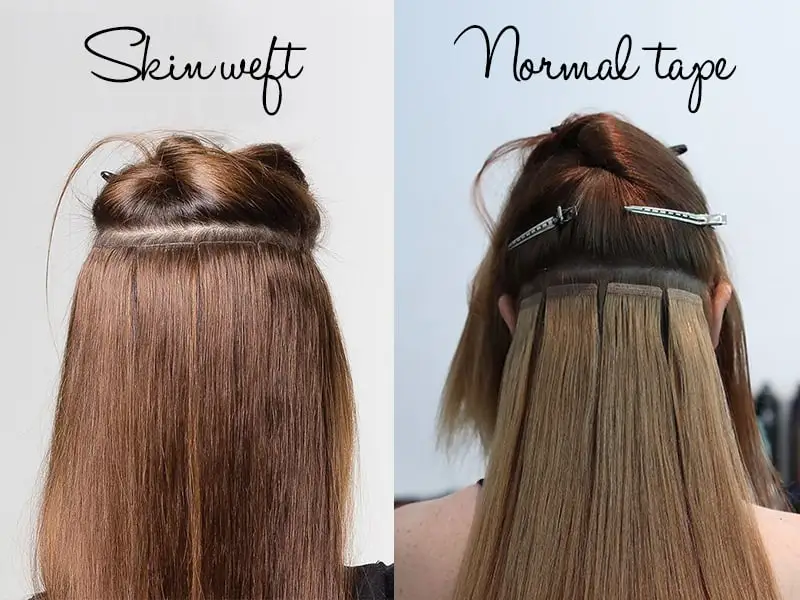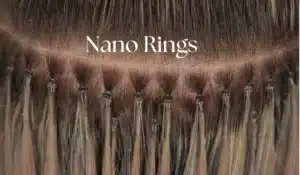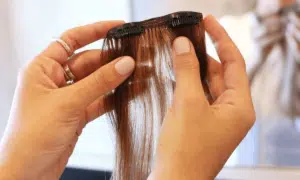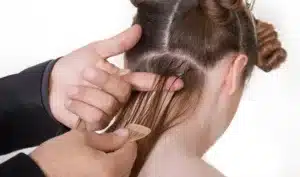Do tape-ins feel delicate to manage? From a manufacturer’s bench, the rules are simple. Follow them, and bonds stay flat, hair stays soft, and cycles run on time.
Factory guidance for maintaining tape hair extensions: keep bonds clean and dry, place products only on lengths, brush with support, sleep in protective styles, and respect a 6–10 week move-up cycle. These habits protect hold, shine, and scalp comfort.

This is a manufacturer’s care manual written for salon owners, wholesalers, and professional stylists. Use it to coach clients, align team SOPs, and reduce callbacks. Each section includes plain rules, quick summaries, and deep practice notes.
Tape ins maintenance?
So how to maintain tape in extensions? Tape-in success starts with predictable daily habits. Small steps keep bonds stable and hair silky.
Daily tape-in maintenance from a factory standpoint means clean bond zones, controlled brushing, smart product placement, and full drying after sweat or showers. These non-negotiables extend wear, protect follicles, and reduce emergency visits.

From production to your chair, adhesive performance depends on surface prep and contamination control. That does not end at install. Clients need a minimal routine they will actually follow. We recommend a soft loop or cushioned brush two to three times a day. Instruct users to support bonds with the free hand and brush ends to roots in short passes. This limits leverage on the sandwich and reduces micro-shifts. Bonds must stay clean and dry. After workouts, hot yoga, steam rooms, or rain, advise clients to towel blot, then blow-dry the first 3–4 inches at the roots on medium heat. Moisture at the bond line is the top cause of early lift. Keep product placement honest: shampoos target scalp, while conditioners, masks, oils, and serums live from mid-length to ends. Nothing oily should touch the first 3–4 cm around the bonds. At night, friction control preserves cuticles. A loose braid or low pony with a soft scrunchie plus a silk pillowcase or bonnet cuts tangles and dryness. Weekly, ask clients to visually check corners. Any lifting tab or tacky feel deserves a professional check rather than a DIY press-down. Clear, repeatable habits are easier to sell and protect both adhesive integrity and strand quality made in our factory.
How to make tape extensions last longer?
You want more weeks between issues and more reuse cycles from each set.Longer life comes from clean installs, oil control at the roots, moderate heat and tension, and on-time move-ups. Consistency beats hacks.

From the factory, we optimize tab fabric, adhesive tack, and strand cuticle. The field result still depends on how clean you keep surfaces. Before first install and every rebond, insist on a double clarify of the natural hair and a zero-residue, fully dry bond zone. Conditioner, leave-ins, and smoothing tonics must never touch roots within the bond area. After install, set rules that clients remember: avoid tight, high ponytails that torque the sandwich; rotate styles to change pull direction; keep hot tools away from tabs; always use heat protectant on the lengths; and blow-dry bond zones to 100% dry after sweat or showers. Strand quality matters. Full cuticle, single-donor human hair resists frizz and keeps shape through multiple re-tape cycles, which lowers the true cost per wear. Educate on grams as well: overloading fine hair with heavy rows invites slip and discomfort. Lighter grams spread across more rows often outlast “max volume” mapping on delicate heads. Finally, lock a maintenance calendar at install—move-up between 6–10 weeks. A scheduled rebond maintains adhesive contact geometry, prevents matting near bonds, and preserves both the extension hair and the client’s own roots. Longer life is a process; teach the process once and hand clients a card to make it stick.
How often do tape extensions need to be moved up?
You need a clear window that fits real growth and daily stress.Most professional programs move tape-ins every 6–10 weeks. Fine hair, fast growth, heavy workouts, or humid climates lean to 6–8 weeks.
Adhesive systems are designed to work near the scalp at a specific leverage angle. As natural hair grows, that angle changes and the bond migrates. The farther a tape sits from the scalp, the more leverage every brush stroke applies. That leverage increases tangling at the seam, stresses follicles, and encourages corners to lift. From a factory perspective, a predictable cycle is the best preventive maintenance. Segment clients by density and lifestyle: fine hair or sweaty routines should return sooner; medium density keeps a standard rhythm; thick or slow-growing hair can stretch closer to ten weeks, provided bonds remain clean and edges are sealed. Teach simple signs for early return: flipping tabs, visible gaps, sticky corners, or brushing that catches near the bond. During a move-up, insist on full protocol—solvent dwell, residue removal, double clarify, 100% dry, fresh professional tape tabs, precise sectioning, and firm, even pressure on placement. Avoid DIY “press-back” fixes that trap residue and contaminate surfaces. When teams pre-book the next visit before checkout, compliance jumps and emergency calls drop. Move-up timing is not a sales tactic—it is an engineering control for consistent adhesive performance and long strand life.
How often should I wash my hair if I have tape in extensions?
You want freshness without loosening bonds.
Two to three wash days per week suits most users. Shampoo at the scalp, keep conditioners on lengths only, and always dry bond zones fully.
Water is not the enemy; lingering moisture at the bonds is. Recommend sulfate-free shampoos focused at the scalp. Clients should emulsify in hands first, then massage with fingertips around, not through, the tape line. Rinse long. Conditioners, masks, and oils stay from mid-length to ends. Clarifying shampoos belong to pre-install or occasional resets, not daily routines. After rinsing, towel-blot by pressing—no rough rubbing that lifts corners. Bond zones must be blow-dried to 100% with medium heat before air-drying the rest. If clients insist on frequent washing, reinforce the “hybrid dry”: roots dried fully, lengths air-dried or diffused. Daily washers should expect shorter cycles unless they follow drying rules strictly. Provide a simple chart: 2× per week for average scalps, 3× for oily or high-activity users, occasional “refresh” days with scalp-only cleansing foams when styling build-up is heavy. The goal is a clean, dry environment around the adhesive and a hydrated, protected environment through the lengths—two zones, two rules. This separation protects bond integrity while preserving the soft, glossy hand-feel your brand promises.
How to sleep with tape in extensions?
Night habits decide how mornings start.Sleep in a loose braid or low pony with a soft scrunchie, and use silk for the pillowcase or bonnet. Dry roots before bed.
Friction and torsion during sleep roughen cuticles and twist sandwiches. The factory view is simple: reduce movement and reduce drag. A loose, low braid distributes tension along the lengths and prevents the heavy mass of hair from pulling on a few bonds. Soft scrunchies prevent sharp pressure points over the tape line. Silk lowers fiber-on-fabric friction, reducing knot formation and dryness. For post-workout evenings, insist that clients dry roots fully before sleep; warm, damp bond zones overnight weaken early-cycle adhesion. Add a two-minute detangle routine before bed—support bonds with one hand, brush ends to roots in short passes. This small habit prevents morning mats that require aggressive brushing. Aggressive morning brushing is exactly what lifts corners or torques bonds. Finally, discourage tight topknots that place direct pressure on the bond rows. A consistent night routine is the most cost-effective insurance for both adhesive hold and the premium strand quality you sell.
Can you air dry your hair with tape in extensions?
Yes for lengths; no for bonds.Always blow-dry the bond area to 100% dry, then air-dry or diffuse the mid-lengths and ends as preferred.
Adhesive systems fail when water and oils linger at the interface. The solution is a hybrid approach. After washing, clients should squeeze-blot water out, then aim a dryer only at the first 3–4 inches from the scalp until bonds are cool and fully dry. Once roots are secure, users can air-dry or diffuse lengths based on their texture goals. If the client uses leave-ins or curl creams, instruct them to apply from mid-length to ends only, avoiding the bond area by a clean margin. Heat tools should remain clear of the tab fabric. Sleeping with damp roots is not allowed; it multiplies lift complaints. In very humid climates, advise a quick cool-shot pass over bond rows before leaving home, since condensation can form near the scalp line. This small habit keeps the adhesive interface stable without adding chair time or complexity, and it preserves the soft movement that premium, full-cuticle hair should deliver.
How to brush hair with tape in extensions?
Controlled brushing keeps bonds stable and lengths glossy.Support bonds with one hand. Brush ends to roots in short passes with a loop, cushioned detangler, or soft boar blend.

Brushing creates the highest day-to-day forces on a bond. As a factory, we design tabs and wefts to tolerate normal grooming, not yanking. Teach a three-zone approach: detangle the last third first, then mid-lengths, then approach the bonds last with minimal strokes. The stabilizing hand above each sandwich converts long lever forces into small, controlled motions. Recommend two to three brush sessions daily—morning, mid-day after wind or workouts, and evening before sleep. Wet hair is weaker; in showers, rely on fingers and wide-tooth combs with slip from conditioner applied only on lengths. After rinsing, blot dry and resume the ends-to-roots pattern. Tools matter: loop brushes slide around bonds; cushioned detanglers provide glide with less snatch; boar blends add shine as a finishing pass. Instruct clients to keep brushes clean; oily bristles contaminate roots and silently weaken adhesive over time. With consistent technique and clean tools, the adhesion system faces far less stress, and the hair retains factory-fresh luster longer.
Can you put leave-in conditioner on tape in extensions?
Yes—keep it away from the bonds.Apply leave-ins from mid-length to ends only. Keep the first 3–4 cm near the bonds product-free to protect adhesion.
From adhesive compatibility testing, heavy oils, butters, and certain silicones migrate and lower tack if they reach the tab interface. Educate clients to read labels: if oil sits in the first few ingredients, that product belongs on ends only. Water-based leave-ins with light polymers work well when sprayed below mid-length. For very dry ends, a pea-size serum can be pressed on the last inches. On humid days, lightweight, water-based formulas control frizz without smothering hair. Remind clients that scent mists and shine sprays count as product—keep them off roots. In salon retail, merchandise “bond-safe” leave-ins together and mark them clearly. This reduces confusion and protects your rebooking schedule. Proper placement keeps adhesive clean while feeding moisture to the lengths our factory carefully preserves through gentle processing.
Does sweat ruin tape in extensions?
Sweat does not ruin tape if moisture is managed.Rinse or blow-dry bonds after workouts, avoid tight hats over rows, and shorten cycles to 6–8 weeks for very active clients.
Sweat contains water, salts, and oils. Left at the bond line, that mix breaks down adhesion and invites slip. The fix is simple: after training, clients should rinse roots with cool water or blow-dry bonds quickly. Headbands and tight caps press sweat into tapes; recommend looser fits or different placement that avoids bond rows. Heavy athletes benefit from slightly shorter move-up windows and stricter drying rules. In hot climates, advise a quick cool-shot over bonds before leaving gyms or studios. Clear guidance transforms “sweat ruins tape-ins” into “sweat managed correctly is fine,” which protects service confidence and real-world results.
What shampoo not to use on tape extensions?
Avoid harsh sulfates, heavy 2-in-1 formulas, oil cleansers at the scalp, and frequent strong clarifiers.
Choose gentle, sulfate-free cleansers for the scalp and keep all conditioning to the lengths.
Shampoo choice influences both adhesive life and strand quality. Sodium Lauryl Sulfate (SLS) and similar harsh surfactants can strip lipids aggressively and roughen cuticles, shortening hair life. Heavy 2-in-1 formulas deposit conditioning agents near the scalp, which migrate to the bond. Oil cleansers at the roots are incompatible with tapes. Strong clarifiers have a place: pre-install and occasional resets—but not daily routines. Our factory recommends a sulfate-free shampoo focused at the scalp, with thorough rinsing to remove foam and residue. Everything nourishing belongs mid-length to ends. This simple separation reduces lift complaints, maintains a clean interface, and delivers the soft, glossy finish expected of premium, full-cuticle extensions.

My opinion
From a factory perspective, for tape in maintenance, simpler rules outperform complicated hacks. Keep bonds clean and dry, teach strict product zoning, control brushing forces, and protect nights. Lock move-ups at 6–10 weeks. Use full cuticle, single-donor human hair for real reuse cycles. This wins client trust and protects brand margins.
FAQ
Will clients lose hold if they wash often?
Not if they dry bond zones to 100% each time and keep products off the roots. Frequency matters less than moisture and oil control.
Can athletes wear tape-ins long term?
Yes, with root drying after every workout, looser headwear, and tighter move-up windows. Many athletes succeed on 6–8 week cycles.
Do hypoallergenic tapes last as long as standard?
Slightly shorter on average, but they release cleaner and suit sensitive scalps. Choose per client history and climate.
Can clients “press back” a lifting corner?
No. That traps residue and weakens the system. Book a professional clean and re-tape to restore a fresh, even interface.
How many reuse cycles can premium hair handle?
With correct care and professional rebonds, many programs achieve multiple cycles across 1–2 years. Monitor cuticle feel; trim ends when needed.
What’s the fastest way to ruin bonds?
Oils or conditioners on the roots, sleeping with damp bonds, and aggressive brushing without supporting the sandwich.
Conclusion
Maintain tape-ins the factory way: clean, dry bonds; products only on lengths; controlled brushing; silk at night; and scheduled move-ups. These simple rules keep holds strong, hair soft, and clients loyal.
Hibiscus Hair Manufacturer has been dedicated to producing high-quality hair extensions for 25 years and is a recognized leader in the industry. If you are interested in finding a reliable hair extensions supplier and wholesale for your brand, please visit our website for more information:
TAPE IN HAIR





